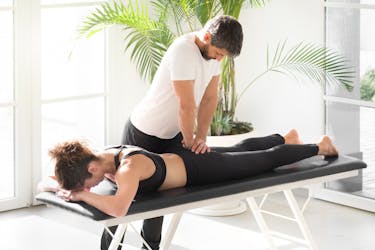
Manual osteopathy could be described in simple, lay terms as “holistic manual medicine”. Manual osteopathy is a system of health care that focuses on osteopathic diagnosis and treatment of the physical body’s structure to optimise physiological functioning. Manual palpation and Osteopathic Manipulative Therapy (OMT) are used in conjunction with biomechanical, orthopaedic and neurological clinical assessment.
Manual osteopathy is best known for treatment of neuro-musculo-skeletal disorders such as back and neck pain, sciatica, sporting injuries and postural strain. Put simply, optimising structural balance allows the physiology to perform optimally.
The practice of manual osteopathy combines current medical knowledge with the osteopathic philosophy. Scientific plausibility and evidence-based outcomes have a high priority in patient treatment and case management. Manual osteopathy is a patient centred approach to health care rather than disease centred.
Osteopathic manual practitioners (also known as manual osteopaths to distinguish themselves from American style osteopathic physicians who perform surgery and prescribe medications) assess and treat the whole person, not just the symptomatic region. So for example if a patient presents with headache they will be structurally assessed from head to toe. This is because the primary cause may be remote from the symptoms. For example; Unilateral pes plannus (flat feet) > functional leg length discrepancy> pelvic torsion> scoliosis> cervicogenic tension headache. This cause would only be detected with an holistic assessment.
Who Can Benefit From Osteopathy Treatments?
Osteopathy is effective for people of all ages, from infants to the elderly. It offers an approach with gentle non-invasive techniques. An osteopathic assessment is so refined that the osteopathic manual practitioner can detect dysfunction without necessarily even having the benefit of a specific complaint, often difficult to obtain from young children.
Osteopathy is equally beneficial to athletes (whether professional or amateur), individuals with problems stemming from a sedentary job or life style, those exposed to occupational hazards, and to people suffering from a wide range of traumas.
Osteopathy can be a complement to medical care for women throughout their pregnancy and to mothers immediately after the delivery. In fact, osteopathy can be very effective in assisting the mother’s body to restore and resume function in the post-partum period.
Osteopathy assists patients to “manage” their own health so that “good health” is restored and maintained whenever possible. The philosophy of osteopathy promotes ‘health’ as opposed to ‘illness’, teaches people to learn to appreciate a quality of life and encourages opportunities to live it to the fullest.
Osteopathy customizes treatments for each individual according to his or her age, physical characteristics and specific reactions to treatments.
